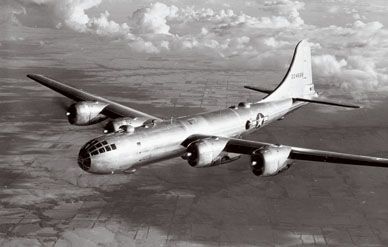Restoration: Best of Seven
The Boeing B-29
OF THE 3,970 B-29 SUPERFORTRESS BOMBERS built by the Boeing Company and its licensees during World War II, only one—Fifi, owned and operated by the Confederate Air Force (recently renamed the Commemorative Air Force)—is airworthy and doing the airshow circuit. If Tony Mazzolini and about 700 volunteers at Boeing’s Wichita plant have anything to say about it, Fifi will soon have company.
Mazzolini, a Continental Airlines employee, had perhaps a hundred hours as a flight engineer aboard Superfortresses while he was in the Air Force. About 20 years ago, a friend told him about the Confederate Air Force and suggested that it could use Mazzolini’s skills. He launched a local wing of the CAF, from Cleveland, his hometown, and the group met to decide on what kind of aircraft they would restore and operate. They knew multi-engine airplanes would earn them the most revenue at airshows, and, as he recalls it, “Someone in back said, ‘How about a B-29?’ ” Mazzolini spent the next four years making phone calls in search of a B-29 they could rebuild, but every lead came up dry.
In 1987 he found his bomber. Since being retired from operational service in 1956, a B-29 named Doc had been sitting in the desert at China Lake Naval Air Station in California, where it had been designated for use as a target for weapon tests.
The airplane took its name from the painting on its nose depicting one of the seven dwarfs from the animated Disney movie Snow White; each of the airplanes in its squadron at Griffiss Air Force Base in Rome, New York, had had a different dwarf on its nose. Out of the entire squadron, which flew radar survey missions in the early 1950s along the east coast of the United States, Doc is apparently the only survivor.
The airplane was missing some parts, but it was the Navy’s airplane, and they drove a hard bargain. Needing a restored North American B-25 Mitchell for the National Museum of Naval Aviation in Pensacola, Florida, the Navy bureaucrats’ proposition was simple: Deliver a restored B-25 and you’ve got your B-29.
Mazzolini learned of a B-25 in Venezuela, bought it, and had it shipped to the States to be restored by the Air Heritage Museum in Beaver Falls, Pennsylvania. Six years later the Mitchell was ready, and in March 1998 the swap with the Navy was completed. Mazzolini, now head of the United States Aviation Museum in Willowick, Ohio, which he had founded in 1992, first had the airplane towed 40 miles across the desert to an airport at Inyokern, California, so work could begin. Awful weather and a lack of equipment and workers dogged the project, so Mazzolini made what he describes as a “cold call” to the Boeing plant in Wichita, where Doc was built. Would Boeing help?
Jeff Turner, a vice president at the plant, approved the proposal, and in May 2000, Doc was disassembled, shipped to its birthplace, and ensconced in Boeing’s experimental-flight hangar.
A volunteer force supervised by Boeing project director Dick Ziegler began the project with a thorough cleaning and polishing. Some of the helpers, like 83-year-old Charles “C.C.” Briscoe, had built B-29s in Wichita during the war at this very plant. Despite 44 years in the desert, Doc is in pretty decent shape, except for some corrosion on the wings and landing gear. Because the airplane had never actually been used as a target on the firing range, only a single bullet hole was found.
The original asbestos-coated wiring will have to be replaced. And the vertical fin and rudder, which had been sawed off by the Navy either to clear some high-tension lines or to reduce the effect of desert winds (depending on whom you ask), will be replaced by one from the New England Aviation Museum in Windsor Locks, Connecticut. Tooling and jigs have been re-created in wood from original drawings, and missing parts have been fabricated from scratch. Ziegler coordinates closely with the Federal Aviation Administration to ensure that the airplane will get an airworthiness certificate upon completion.
The crucial question, of course, is when will Doc fly? Ziegler steeples his hands, smiles, and says, “I’m an optimist, but we’ve got momentum. Local companies and donors everywhere have been most supportive. If we don’t get any serious curve balls, I’d say end of 2002.”
And will Doc go to Cleveland or remain in its birthplace? “Tough to say at this point,” says Ziegler. “We’ve had an offer of a new hangar right here [in Wichita]. Right now it’s up in the air.” Mazzolini adds, “The people in the Kansas community would like it to stay there. I’d like to park it right out in my back yard, but I know that wherever it’s based, I’ll have to fly to it.”
